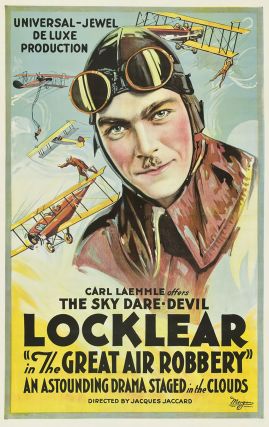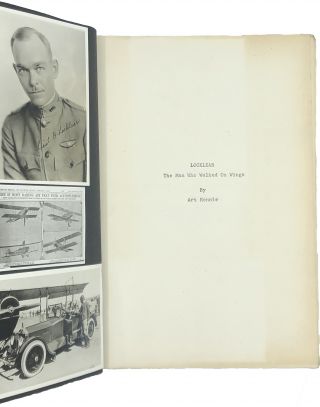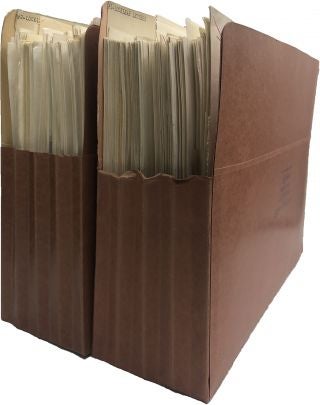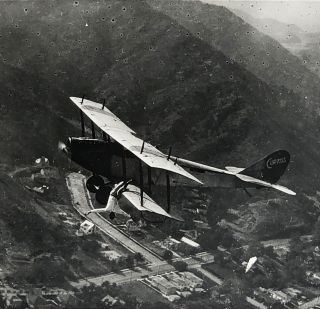ORMER LOCKLEAR ARCHIVE
An archive of research and writing materials gathered for a biography of Ormer Locklear, the daredevil aerial stuntman who was the first to change planes mid-air and died while filming the silent movie The Skywayman (1920). It took more than a decade for author Art Ronnie to research Locklear’s life and find a publisher for his book, Locklear: The Man Who Walked on Wings (1973).
Born in Greenville, Texas, Locklear (1891–1920) became fascinated with flying when aviation pioneer Calbraith Perry Rodgers landed in a Fort Worth field to unclog a fuel line. With his brothers, Locklear built gliders and later, learned to fly after joining the U.S. Army Air Force in 1917, eventually becoming a flight instructor. He left the Army in 1919 and with two colleagues, joined show promoter and manager William Pickens to form an aerial circus before he was recruited for the silver screen. In his personal life, Locklear married Ruby Graves in 1915, but they separated in 1919 and thereafter she refused to grant him a divorce. After moving to Hollywood, he became involved with silent screen actress Viola Dana, who was at the airfield the night of the accident and witnessed his death. One of the key items in this archive is a scarce, original poster for Locklear’s first feature film, The Great Air Robbery (Universal, 1919). After watching one of Locklear’s aerial circus shows, Carl Laemmle signed Locklear to a series of motion pictures. In this movie Locklear played Larry Cassidy, a pilot for the U.S. Air Mail Service, who defends a shipment of $20,000 in gold from the villainous clutches of the evil Chester Van Arland (Ray Ripley). The film made use of all the stunts that had made Locklear a household name as a barnstormer. The picture was a hit, and Locklear was well on his way to a fabulous career on the silver screen. The stone lithographic posters measures 27” x 41” and features a portrait of the daring aviator. It is archivally framed with an acid-free mount and UV plexiglass. This film and The Skywayman are both considered “lost films” as no known prints exists in archives.
This archive also includes more than 300 hundred negatives and photographs of Locklear’s short life and career that were collected by Art Ronnie from Locklear family members, newspapers, movie studios, and historical societies. Included among them is a framed 8” x 10” black-and-white photograph that is signed by Locklear who is wearing his military uniform. A second framed photograph from his Hollywood days includes a signature framed below the photo. Neither of these images have been inspected outside the frame. Ronnie was a meticulous record keeper. This archive includes copies of letters the author wrote to Locklearfamily members, friends, film studios, libraries, and historical societies. It includes two expandable folders containing copies of the more than 300 letters Ronnie wrote researching the book, with the recipients’ responses attached. He began his research in 1961 while working at the Los Angeles Herald Examiner, using the newspaper’s stationary with the intention of writing a magazine piece on spec.
After the initial article was published, he decided to pursue a book and many of his later letters reflect the struggle to find a publisher. By 1962, he is using Twentieth Century Fox Television letterhead after having switched careers to be a publicist with the network. Among the early letters Ronnie wrote is one to Locklear’s sister, Anita Mae Locklear, who still lived in the family’s hometown of Fort Worth, Texas. “Would you please write down anything you recall about Ormer – his personality, his motorcycling and racing days, any amusing anecdotes, his first desires to fly, his decision to come to Hollywood and his funeral, which I understand was one of the largest ever held in Fort Worth.” In her return letter, Anita shared a few facts: “He was flying with Pickens Flying Circus when the studio was interested and signed him up for the pictures.” Ronnie appeared to have the most success and the longest running correspondence with Locklear’s brother, James, who became the point person for the family. The two men corresponded excitedly after uncovering a copy of the Barron Field Review, which contained a photo feature of “Locklear’s Class in Aerial Calisthenics.”
Ronnie tracked down one of Locklear’s fellow aviators, who recalled in a letter that Locklear was fearless and often got in trouble for aerial antics: “He liked stunts and thrills and experimented with crawling all over the plane, which finally gave him the idea that he could change planes in the air.” Among the letters is a typed, signed reply from the actress Mary Pickford, who provides Ronnie with a contact to Charlie Chaplin and notes that her brother Jack and Ormer were good friends: “On the night that Locklear was killed my brother was scheduled to go up with him, but mother had prepared Jack’s favorite dinner, and as luck would have it, the dinner was late.” Ronnie also chased down leads that didn’t pan out. He corresponded in 1961 with movie producer Robert Youngson about a rumor that Locklear was one of the stunt pilots involved in the unplanned mid-air collision of two planes during the filming of the Harry Houdini movie The Grim Game. “My own guess is that the stuntman on that wing could not possibly have escaped and must have been killed,” Youngson wrote. The publicity machine around the 1919 film claimed Houdini was involved and escaped the crash, but Ronnie’s research uncovered the fact that Houdini was nowhere near the planes. Miraculously, his stunt double survived the crash with just a few cuts and bruises.
After working on the project for more than a decade, Ronnie landed A.S. Barnes as a publisher. One of the folders in this archive contains dozens of rejection letters he received from publishers between 1962 and 1971, when he signed his publishing deal. For the first several years, he was represented by literary agent Carolyn Willyoung Stagg of Lester Lewis Associates. After receiving feedback from Holt, she wrote the following in January 1962 to Ronnie: “Are you at all interested in doing a couple of consecutive chapters which will be less ‘journalistic and slap-dashed style’ and will get down the essential motivation and characterization which made Locklear a colorful figure?” In 1969, Barnes rejected Ronnie’s manuscript but decided to move forward with it in 1971. He was paid a $250 royalty advance. Once the book went to press, Ronnie pushed the publisher about its promotion and sales strategies, taking on much of the public relations campaign himself, calling in favors and urging those he knew in the media to mention his book. He seemed less impressed with Barnes’ sales efforts, writing to Julien Yoseloff of Barnes in October 1973: “When a book has received the publicity Locklear has, I believe it behooves the publisher to let the booksellers know about it…I believe the publicity Locklear has received in very unusual. In addition to reviews, more than 800 newspapers have mentioned it and excerpts have appeared in eight magazines.” Ronnie’s personal copy of the book is included with the archive. It contains his bookplate and is inscribed by Viola Dana and her sister Shirley Mason, also an actress from the silent film era. This copy is also signed by Jimmy Doolittle, who provided Ronnie with an opening quote for the book.
The materials, including several typescript versions of the book, in this collection are stored in three banker boxes and all the materials are in very good condition. This archive provides a complete record of an important early aviator who transitioned into movie making. In addition, it is an important writers archive demonstrating how original research is developed and the evolution of a book, as well as its printing and promotion. Please inquire for a complete inventory of this archive. Item #74692
Price: $9,500.00





